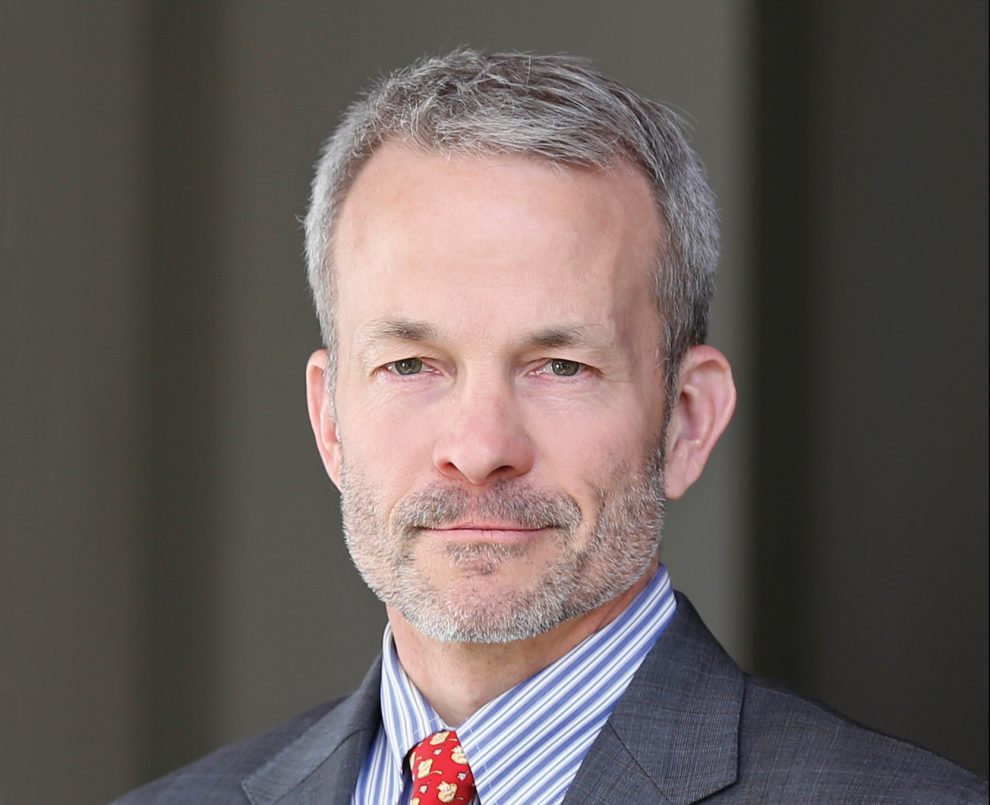For decades, Catholic Relief Services CRS) has been one of the world’s leading humanitarian aid agencies, serving and supporting vulnerable populations in 114 countries. While engagement with U.S. Catholics has always been a part of CRS programming—with well-known projects such as the annual CRS Rice Bowl Lenten program and other education and fundraising initiatives—a new strategy focused on advocacy and action aims to include U.S. Catholics in an ongoing and sustainable way.
The strategy, which involves creating local CRS chapters across the United States, began in 2019 to bring together “communities of Catholics and other people of goodwill with an interest in supporting the mission of CRS through measurable steps of advocacy and fundraising,” says Bill O’Keefe, executive vice president for mission, mobilization, and advocacy at CRS. The new methodology of building and supporting chapters in parishes, high schools, and universities allows participants to join CRS’ work while they establish ties within their local communities and with their local, state, and national representatives, which is a key component to the project’s success.
After one year and the formation of more than 40 chapters (with almost another 40 in development), O’Keefe sat down with the U.S. Catholic editors to talk about why it’s important for Catholics to get involved in advocacy efforts and how they can effectively influence policy decisions that are important to people of faith.
What are Catholic Relief Service chapters?
Catholic Relief Service (CRS) chapters are local communities of people who support CRS’ mission through measurable steps of advocacy and fundraising. The formation of the chapters is part of a strategy that CRS has crafted in response to the overwhelming set of problems we see around the world.
We’re not a social movement. We’re part of an institution—the Catholic Church. We asked, “What is an authentic way for us—given the teaching of the church, the structure of the church, and where we fit into it—to begin to do this?”
There’s a four-month cycle for forming new chapters. CRS provides training, materials, fellowship, prayer resources, and action items. Some of the advocacy tools that we provide include how to write an effective letter to the editor that gets printed, how to get and have a successful meeting with your member of Congress, and how to organize a meeting of your chapter in a way that is successful and engaging.
What is an authentic way for us—given the teaching of the church, the structure of the church, and where we fit into it—to begin to do this?
At our current rate of growth, by 2030 we’ll have thousands of chapters with tens of thousands of members who are mobilized to take concrete action. We’re building a movement of people in the United States who are engaged in changing the root causes of poverty and injustice that CRS sees every day in the countries where we operate.
How does the work of CRS chapters fit into the greater Catholic call to work for justice?
We’ve organized our work around campaigns focused on major issues of justice and human dignity. We have two main campaigns right now—Lead the Way on Hunger and Lead the Way on Migration—that address a host of problems related to those two major issues. For example, we’re engaging people in addressing how our government can do more about the root causes of migration, which we have a clear perspective on because of CRS’ work in Latin America. We know what the root causes are and what our government could and should be doing about them. How do we protect people from violence and poverty in their home countries? How do we help them to be able to stay where they are and live with dignity and hope of opportunity for their families? These are significant justice questions.
What are some of CRS chapters’ successes?
One of the pieces of legislation that has been part of our hunger efforts is the Global Child Thrive Act. It’s a bill in Congress that would require the U.S. government to integrate best practices from CRS programming around the world in parenting, family support, nutrition, and school readiness so that children are set up for success for the rest of their lives. It’s been amazing how many members of Congress have agreed to sponsor the bill as a result of a meeting with a local CRS chapter.
How do we protect people from violence and poverty in their home countries? How do we help them to be able to stay where they are and live with dignity and hope of opportunity for their families?
The Global Child Thrive Act is still working its way through the legislative process, so we don’t know yet what the ultimate result will be. It has moved to the House of Representatives and has been marked up by the committee. Our chapter members were huge supporters to committee members to pass that bill out of committee. In both the House and Senate among both Democrats and Republicans, chapters have brought many sponsors and cosponsors for the bill. It’s been exciting to see.
How do you decide which issues the chapters will engage?
Everything we do connects to Catholic teaching, but something such as water-smart agriculture—a farming practice that balances the cost of production, increasing yields, and environmental sustainability—doesn’t evoke one’s faith at face value the same way hunger does. We need something at that level.
We look for serious underlying issues that can include a number of different actions. We want something where we can get people to be experts and advocates over time. So we have to pick something that can include several different actions that all connect with the goal, but through which we can sustain commitment and energy.
Everything we do at CRS comes from our experience of our programming around the world so that we have something credible to talk about, people who can represent it, experience from the local church, and partners to bring to bear. That’s important.
All the issues we advocate on, our policy frameworks, everything we’re doing is within the context of what the U.S. Conference of Catholic Bishops is advocating.
What happens during a chapter meeting?
We first conduct a four-part formation and training process for each beginning chapter and chapter leader to give them the basic idea and tools. Then we have a monthly national chapter call with a speaker who talks about the issue we’re working on at the time. This could be a well-known expert and academic, a bishop, a CRS partner from around the world, or anyone who can go deeper into the meaning of the particular issue.
Next we discuss what’s working and what’s not working. People share success stories, and CRS provides some content about best practices and recommendations. A meeting then finishes with action steps for the next month.
The goal is to tap into people’s desires and calling to be missionary disciples, to take the gospel and put it into action through their faith lives.
The chapters meet on their own between national calls. They get a monthly action sheet that has specific actions and tools to take those actions. CRS also provides materials for prayer reflection and chapter building.
We’ve made a lot of progress in measuring and evaluating success in advocacy. By tracking the phone calls and meetings that chapter members have with members of Congress, we can measure the actions people take. Then we can say with some degree of confidence, “We are making a difference. This movement is having an impact.”
People are incredibly busy. We want to make sure that if we ask for their precious time and commitment, we can say that it’s worth it. We want to be able to demonstrate to our board, participants, the people we serve, and our partners around the world that we are making a difference.
What is the goal?
The goal is to tap into people’s desires and calling to be missionary disciples, to take the gospel and put it into action through their faith lives. How we organize, communicate with, and engage our chapters is all consistent with that and with the church’s calling for us to live out our faith in concrete and actionable ways.
In addition to feelings of success, people want to be a part of something bigger than themselves. This was an interesting lesson of the COVID-19 crisis. When everything first shut down, we had discussions about whether we should pause the program. Everybody was anxious. Everybody was dealing with a plethora of problems. We decided to move forward under the hypothesis that people, particularly at this time, want to step outside of themselves and feel something beyond helplessness, hopelessness, and fear.
Why did CRS decide to do this now?
We developed a new agency strategy and set five goals with indicators of the kind of impact that we want to have: (1) all people live in just and peaceful societies; (2) all people survive and thrive in the face of disasters; (3) all people achieve dignified and resilient livelihoods in flourishing landscapes; (4) all children reach their full health and development potential in safe and nourishing families; and (5) all youth are empowered to thrive. After doing this, it was clear that we cannot do this on our own. We need to get the U.S. government to do more and change some of the ways it operates, because it impacts the kinds of problems
CRS addresses around the world. The only way to get our government to take those kinds of steps is if faithful people are willing to take a stand.
How is this different from the way CRS has engaged U.S. Catholics in the past?
We’ve always had groups of supporters at parishes or schools, but they’ve been pretty independent. Now we’re knitting them together into one strategy that’s pointed in one direction with one set of actions.
For example, there is an amazing group of Catholic activists in the Archdiocese of Philadelphia. We brought together a number of our groups from different audiences as part of an advocacy committee, and together they’ve made some huge collective changes they could not have made on their own.
Anybody can take action to advocate to our government about issues related to refugees and migration and hunger.
In New York we did statewide virtual advocacy with college students, parish men’s clubs, CRS Rice Bowl groups, and CRS chapters. Everyone mobilized the same actions at the same time on the same day. That’s really powerful: It helps to break down silos within the communities of the church and energize parish life. We’ve heard from pastors and parishioners that it’s making a real difference in those communities.
Are other Catholic groups doing similar work?
Many Catholic groups are trying to figure out how to engage more people through social ministry. What’s different about our methodology is we’re designing it to scale. We have a limited number of staff. Dioceses have a limited amount of resources, and lack of resources can restrain growth. We’re designing a system that doesn’t depend on having an expanded number of staff in order to expand.
Folks in dioceses are critical for our strategy. They’re significant partners who are important for building support, connecting the global mission of the church with the local activities of the diocese, and identifying leaders. But if everything depends on them, it
can go only so far. We’re hoping that CRS chapters will enable the capacity that’s already there to have more impact. That’s the big challenge.
Are Catholics called to political advocacy?
The church calls us as members of a society to have a responsibility to the more vulnerable members of that society. We can’t just sit by without taking some sort of action. Everyone has to figure out what the right action is for them in their context and in their conscience. What moves them?
We hope individuals will join chapters, but you don’t have to be a chapter member to advocate for justice. Our campaigns are broader than chapter work. The chapter members are the best trained and most committed. They take the most important actions. But anybody can take action to advocate to our government about issues related to refugees and migration and hunger. CRS provides tools to do that through our campaigns and invites everyone to get involved. Get your non-Catholic friends to help too, because these problems are bigger than we are.
What are some struggles for Catholics who are involved in advocacy, especially those who are living their faith in this way for the first time?
It might seem political at first. We’re not asking people to get involved in politics, and we’re certainly not asking them to get involved in the polarized, partisan debates that are going on in our country. We are asking them as citizens—and the church asks them as citizens—to get involved as members of a democracy in expressing their views so that society can be better aligned with the teaching of the church and the consciences of Catholics.
Another thing people grapple with is anxiety about talking with a member of Congress. They think members of Congress don’t have time or aren’t interested in what they have to say. They’re nervous, but if we prepare them well—and that’s what our methodology is designed to do—every single time after they have their first meeting they say, “That was great!”
We are asking them as citizens—and the church asks them as citizens—to get involved as members of a democracy in expressing their views so that society can be better aligned with the teaching of the church and the consciences of Catholics
I do a lot of lobbying on Capitol Hill, as do others at CRS. Although members of Congress are interested in what we have to say, they’re a lot more interested in what a Catholic in their district has to say.
Congress members recognize that CRS is a great organization with a lot of experience. But it’s much more impactful when actual people who vote show up and say, “I support the Global Child Thrive Act. I have children. I know firsthand what it takes to prepare kids to be ready for school. I want children in Kenya to have the same opportunities as my child. That’s what my faith calls me to do and that’s what I’m asking you to do.” Direct constituent engagement is what makes the difference.
What have you learned in the first year with CRS chapters?
Catholics really do care. They want to be asked to take action. They’re willing to take action. They want to live their faith.
This article also appears in the November issue of U.S. Catholic (Vol. 85, No. 11, pages 18-21). Click here to subscribe to the magazine.
Image: Courtesy of Bill O’Keefe















Add comment